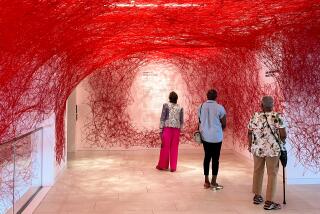Critic’s notebook: The Getty Trust presidency needs to be abolished
In March, a “help wanted” ad appeared on the J. Paul Getty Trust’s website. Amid listings seeking an HVAC technician, a security officer and an audiovisual specialist came four succinct paragraphs, highlighted by this description:
“The trust is currently seeking a Director for its Museum. The individual will be critical to the success of the organization, reporting directly to the President, with responsibility for all Museum activities including budget, acquisition strategy and personnel decisions....”
The text also noted that “the Trust consists of four strong, programmatic components—the Getty Museum, Research Institute, Conservation Institute and Foundation.” It went on to express a desire for “an inspiring leader, with an outstanding record, who has the skill to recruit, strengthen and retain a staff of professionals while generating positive morale throughout the organization.” Unusually for such a major job, an outside executive search firm is not being retained. The ad is still posted on the website, together with a risible invitation to apply online, which no credible candidate is likely to do.
It confirms something I’ve been thinking for a while. Although the Getty Trust might have a candidate in mind, it should abandon the director search. Instead, the institution’s creaking, obsolete governing structure needs to be reorganized.
Simply put, the Trust format has outgrown its usefulness and deserves a decent burial. The plainest evidence that it doesn’t work is that the Trust’s museum has had three directors since the Getty Center’s 1997 opening. The turnover is telling.
The Getty Trust was created 27 years ago. It absorbed what had been a small, rather sleepy museum adjacent to Malibu, in a city that was just beginning to shake off its longstanding legacy as a cultural backwater.
The Trust was devised to oversee several ambitious new initiatives: the aforementioned research and conservation institutes and grants foundation, plus two projects that have since been dismantled — one in electronic information, the other in public school art education. These programs, each acting as an independent entity, operate from a lofty Brentwood campus, which finally opened in 1997.
As with most things Getty, the explanation for creating this elaborate structure is simple: Follow the money. The Getty had too much of it, thanks to J. Paul’s jaw-dropping 1976 will.
The 4 million shares of stock the late oil baron left to endow his modest, Roman-style villa meant it was suddenly five times wealthier than the nation’s largest, most prestigious art institution — New York’s mighty Metropolitan Museum of Art. For the little Getty to deal with such an embarrassment of riches was not easy.
Suddenly faced with an annual requirement to spend about 5% of a huge endowment, it had to diversify. The Trust was created as an umbrella, beneath which programs for global cultural needs might huddle.
The world, though, is very different now from what it was then. For one thing, L.A.’s local cultural needs got somewhat lost in the global shuffle, even as they were growing. The Getty is certainly involved in the city’s cultural life — but partly because of its two inconvenient (if lovely) locations, partly because its permanent collection has never seemed to be the highest priority and partly because of its far-flung initiatives, it has also always felt remote.
For another, the Trust president once had to be mostly a money man, to untangle Getty’s complicated bequest. (The first president came from the Securities and Exchange Commission in Washington.) Today, highly paid investment and financial officers handle the long-settled endowment.
Mostly, though, the tough problem of too much money that the Getty initially faced has been turned on its head. Recent program cuts and staff layoffs in the wake of the economic downturn underscore it. Expenses have been shaved 25%, from $289 million in 2008 to $216 million this year.
So the big institution’s program has contracted. Meanwhile, the cost of art has not.
Consider Rembrandt. The year J. Paul Getty died and his will was read, making his art museum a financial powerhouse, Rembrandt’s painting “Juno” made headlines when it sold for a record price of $3.25 million. Last December, his “Portrait of a Man With Arms Akimbo” set another record. The price this time was $33.2 million, a sum 10 times larger than “Juno.”
Even adjusting for inflation, the new record is nearly triple the old one. The Getty acquires just a few important paintings and sculptures annually (private collectors bought both Rembrandts), so overall the collection continues to lag.
America’s putatively richest museum is financially squeezed. The director faces a $100,000 limit on discretionary expenditures for art acquisitions. Meanwhile, the Trust president controls tens of millions of dollars in acquisition funds. Collection-building is a museum’s premier function, so conflict between director and president is inevitable.
The museum is still by far the Getty Trust’s largest program. But it needs maximum flexibility, not leadership conflict. So, what should happen now is obvious: Combine the Trust presidency and the museum directorship into a single job. That would solidify the museum as the primary endeavor — which is also what the late benefactor envisioned.
And wait a year to fill the newly combined post. Current Trust President James Wood retires in 2012.
The Trust’s three other programs should be consolidated under the museum’s direction. The existing program heads might not be thrilled with that, but any structural tensions would dissipate over time. Besides, deputies reporting to the museum director wouldn’t be much different from program directors reporting to the Trust president now.
The director’s job listing on the Getty website even demonstrates why the existing Trust structure is futile. Did you catch its barely concealed booby trap?
The new director will assume “responsibility for all Museum activities,” which is established professional practice. But because he or she will be “reporting directly to the President,” the director will not have full administrative authority for those decisions. The Trust’s chief executive will.
Full responsibility without full authority is a prescription for museum failure. And that’s what has happened—repeatedly.
The current vacancy became known Jan. 7, after Wood asked for the resignation of the museum’s able director, Michael Brand. The two men reportedly clashed over acquisition budgets, long-range planning and other issues.
That’s no surprise. Similar clashes marked the tenure of Wood’s and Brand’s respective predecessors.
The dichotomy between responsibility and authority helps to explain why the museum directorship has become a revolving door. Brand and his immediate predecessor, Deborah Gribbon, each stayed for just four years. The brevity of their tenure in what ought to be a plum museum job cannot be waved away as an aberration.
In size, the once-small institution is now more like the gigantic Met, where the endowment has grown from one-fifth of the Getty’s to about one-half. Continuing a split Getty leadership between the museum and the Trust just begs for trouble.
No administrative structure is flawless, and individual personalities do go a long way toward determining outcomes. But a multi-headed Hydra has bedeviled the institution. The museum director should be in the driver’s seat. Meanwhile, the separate job of Trust President has frankly outlived its purpose.
christopher.knight@latimes.com
More to Read
The biggest entertainment stories
Get our big stories about Hollywood, film, television, music, arts, culture and more right in your inbox as soon as they publish.
You may occasionally receive promotional content from the Los Angeles Times.











